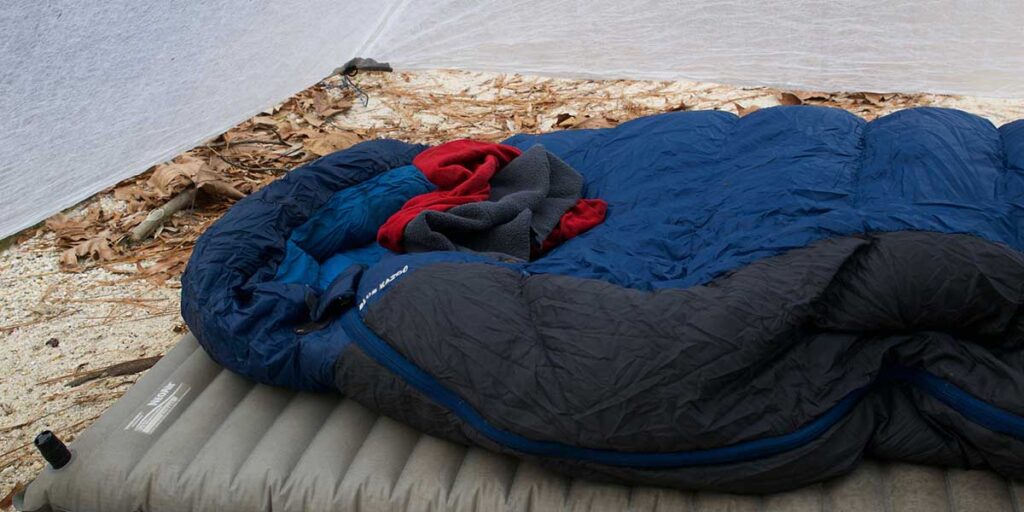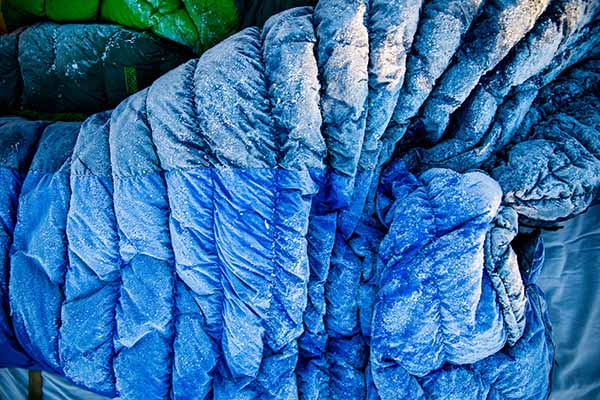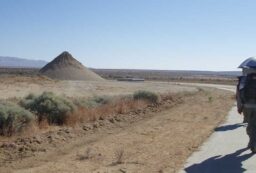The weather is getting colder, you still want to go camping but you don’t want to buy a new (and probably expensive!) sleeping bag. So, you are wondering whether you can nest two sleeping bags to make one warmer bag. Here’s what you need to know about putting one sleeping bag into another to bump up the temperature rating.
Also read:
Can you sleep in two sleeping bags in cold weather?
Yes, you can absolutely double up on sleeping bags. It will definitely be warmer than sleeping in just one sleeping bag. The problem is that it is that very difficult to know exactly how much warmer the bags will be once combined, especially because the insulation can get compressed and won’t trap heat as well. You could end up freezing in the doubled bags. Or you could end up hot and sweaty. Both outcomes can be risky when camping in very cold weather.
Tip: You can often find good deals on winter sleeping bags in REI’s Outlet section
How Warm Will Two Sleeping Bags Will Be? The Math Formula
You can use this math equation to get an approximate idea of how warm two sleeping bags will be once nested together:
(x– ((70-y)/2) = z
Where:
- x = comfort level rating of warmer bag in F
- y = comfort level rating of colder bag in F
- z = new comfort level rating of combined bags
For example, let’s say you nest a 30F bag and a 50F bag:
30-((70-50)/2)
30-(20/2)
30-(10) = 20F
Based on the formula, combining these two sleeping bags would keep you comfortable down to 20F.
The Logic Behind the Math
Even though this equation is floating all around backpacking forums, no one seems to know where it originated. The 70 in the equation likely is our comfort level in pajamas. The rest likely has to do with how well sleeping bags retain heat across layers of insulation.
Don’t Rely on the Double-Bag Formula!
The formula can usually give you a good idea of how warm your nested sleeping bags will be. For example, this camper said that 15F + 35F bags keep him comfortable at zero degrees – which is pretty close to what the formula predicts.
However, no math equation can accurately tell you how warm two nested sleeping bags will be!
There are simply too many variables, such as:
- How much the insulation gets compressed
- Personal comfort level
- Air gaps
- Breathability of the nested bags
For example, David Freeman wrote that he uses a 15 degree down bag with a 40 degree synthetic bag when camping at -30 degrees F. According to the double-bag formula though, this should only keep him comfortable at 0F. He’s obviously a warm sleeper.
By contrast, his wife needs the 15 degree bag with a -10 bag at -30F. According to the formula, this setup should keep her warm at -37.5F. There’s a huge comfort difference between -30 and -37.5F!!!
Which Sleeping Bag Should Go on the Outside?
When combining two sleeping bags, you generally want to put the thinner bag on the inside. The reason is because sleeping bag insulation doesn’t trap heat well if it is compressed. You want your nested sleeping bags to have the most loft (aka fluffiness) possible.
Some backpackers even recommend testing this out:
- Open the sleeping bags up.
- Layer one on top of the other.
- Measure how many inches of loft you get.
- Now layer the other bag on top and measure the loft.
- Whichever setup gives you the most loft is best.
Down or Synthetic Bag On the Inside?
If using a down and a synthetic sleeping bag together, then the down sleeping bag should be on the inside. Even if the down bag is thicker, this setup is better for moisture control: putting the synthetic bag on the outside helps keep your down bag dry.
Your body produces a lot of water vapor. This water vapor will travel outwards through your sleeping bag until it reaches a temperature where it condenses into water – which will likely be at the outermost layer of your sleep setup.
You do not want it to condense into water in your down sleeping bag! Synthetic bags can handle getting wet better, which is why it’s better that the dew point forms in the synthetic bag. Also, if condensation starts dripping in your tent, it’s better to drip on your synthetic bag than the down bag.
Of course there are exceptions to this rule. If you are using a vapor barrier liner, then it won’t matter much. If your synthetic sleeping bag is very heavy, then you wouldn’t want it on top where it would compress the down…
The Breathability Problem of Using Two Sleeping Bags
Another potential issue with combining two sleeping bags is that you lose breathability. The setup ends up hot and stuffy. The compressed sleeping bags trap your sweat, meaning you end up wet. Next thing you know, you are freezing cold because of evaporative heat loss.
For this reason, a lot of backpackers will actually drape the second sleeping bag over the first. Or unzip it almost all the way and only nest the foot area. This setup does create huge air gaps, but at least you don’t lose breathability.
Test Before You Go!
If you are car camping and can bring (lots of!) spare blankets and layers in case you end up cold, then it’s probably fine to risk sleeping in your two-bag setup. But, if you are backpacking in the middle of nowhere, it could be legitimately dangerous to rely on two sleeping bags.
Ideally you would test out your system in your backyard. Or rent a cabin somewhere and camp in front of it. If you end up miserably cold, you can always retreat into the cabin.
Definitely don’t test out the two-bag system on multi-night trips. And, at the very least, make sure you have an exit plan in case things go badly.
Sources:
https://backpackinglight.com/forums/topic/50602/,
https://www.reddit.com/r/CampingGear/comments/6q7hy9/using_two_sleeping_bags_nested_in_one_another_is/,
https://www.reddit.com/r/Ultralight/comments/5pludi/adding_sleeping_bag_warmth_together/,
https://backpackinglight.com/forums/topic/89063/,
https://backpackinglight.com/forums/topic/101595/,
https://backpackinglight.com/forums/topic/56548/,
https://bwca.com/index.cfm?fuseaction=forum.thread&threadId=550994&forumID=15&confID=1
Image credit: “Hot and Cold” (CC BY 2.0) by Zach Dischner,
“Tips for Winter Camping.” (CC BY 2.0) by vastateparksstaff














3 Comments
Bill
July 4, 2023 at 4:02 pmThe warmest solution I’ve used for years is using 1″ foam insulation inside my sleeping bag, both over me and under me. You can attach the foam to inside your sleeping bag many different ways so it stays in place during the night. Like a pillow case, sew two bed sheets together for a foam covering.
Diane
July 5, 2023 at 10:22 amHmmm… that’s a cool solution. Did you have any problems with getting sweaty since foam insulation isn’t breathable?
Bill
July 23, 2023 at 7:24 pmLately, I’ve been using three sleeping bags unzipped on my cot. One bag is my bed sheet under me, and the other two are my top cover and comforter over me. So far it works like a charm while sleeping in my tent.